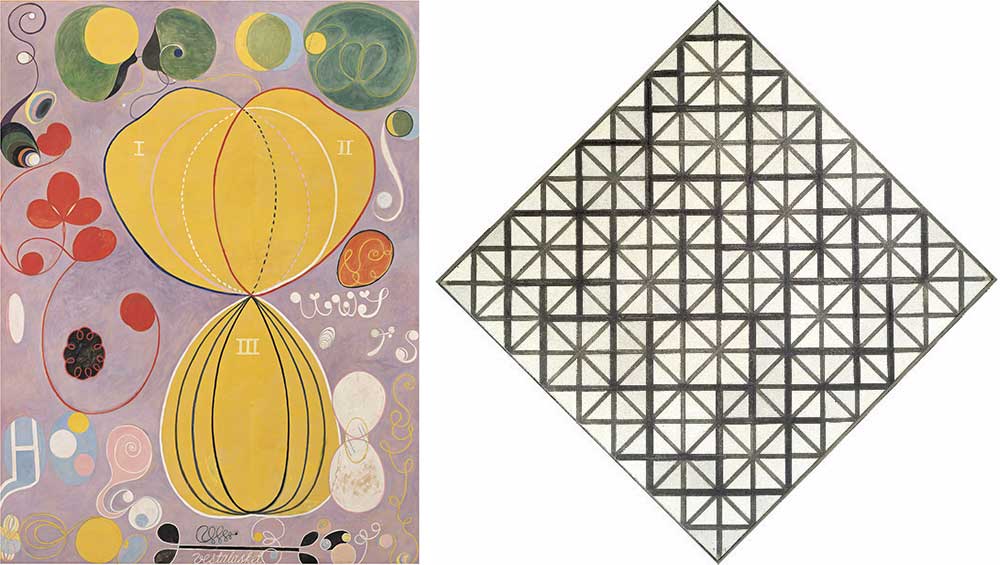
Left: Hilma af Klint, The Ten Largest, Group IV, No. 7, Adulthood, 1907. Courtesy of The Hilma af Klint Foundation. Right: Piet Mondrian, Composition with Grid 3 Lozenge Composition with grey Lines, 1918. Kunstmuseum Den Haag.
Tate Modern, London
20 April – 3 September 2023
by TOM DENMAN
Dual exhibitions hinge on an often ethereal affinity between two artists and their creations. The individual masterpieces still transfix us, but our viewing of them is insistently framed by their relation to others. Tate Modern’s alignment of Hilma af Klint (1862-1944) and Piet Mondrian (1872-1944) does this in a very interesting way. Not only were the artists unacquainted, but neither knew of the other’s work – unlike most cases (Matisse/Picasso, Michelangelo/Viola, Munch/Emin, Beuys/Gormley, to name a few examples), in which at least one artist is aware of, and often influenced by, the other. Such unacquaintance in person and practice is all the more remarkable because they were close contemporaries, both living in Europe (albeit Mondrian “boogied” his final years in New York), and their most tangible link has hardly anything to do with artistic influence. In their respective countries, both Af Klint and Mondrian were members of the transnational Theosophical Society, which promoted an esotericism that amalgamated science, philosophy and world religion, and was fundamentally concerned with the idea of affinity itself – as the basis of the interconnectedness of all beings.
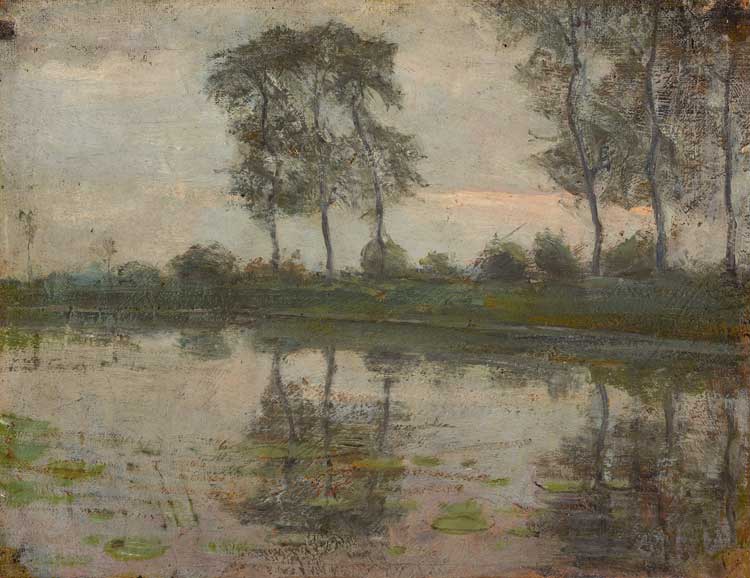
Piet Mondrian, The Gein: Trees along the water, c1905. Oil on canvas on panel, 25 x 32 cm. Kunstmuseum Den Haag.
The show begins with the two artists training as landscape painters: Af Klint at the Royal Academy of Fine Arts in Stockholm, Mondrian at the Rijksakademie van Beeldende Kunsten in Amsterdam, where they enrolled in 1882 and 1892 respectively. Here, the small and careful countryside views foreshadow each artist’s fascination with the shape of nature as an all-encompassing unifier. Hence comes the organicism underlying the abstractions for which both artists are best known, which approximate nature’s “forms” – a term from the title which asks to be read in the Platonic sense, according to which the form of a thing is its abstract, intangible essence. While this notion famously influenced the onset of abstract art, Plato and Platonism were also central to Theosophical thought, and the subject of several essays by the Russian mystic Helena P Blavatsky, who co-founded the society in New York 1875.
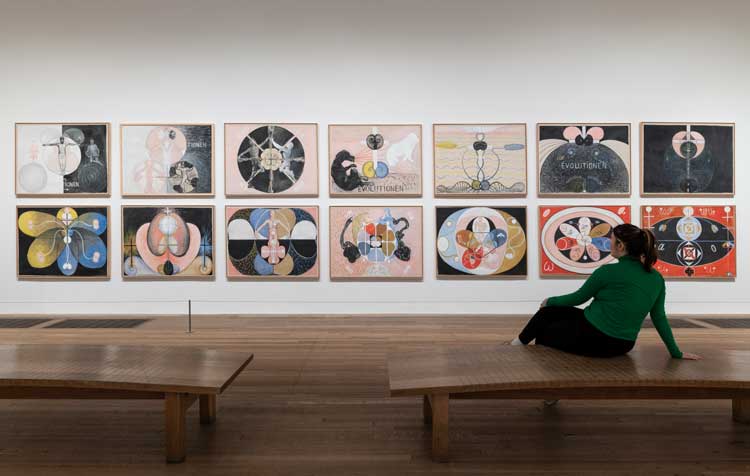
Hilma af Klint & Piet Mondrian: Forms of Life, installation view, Tate Modern 2023. Photo: Tate (Jai Monaghan).
One almost hears a choral ahh on entering the second room. Along one wall are canvases from Af Klint’s The Paintings for the Temple, a series she worked on between 1906 and 1915, in which she channelled the guidance of Amaliel, one of the five “High Masters” that she and her spiritual collective, The Five (“De Fem”, in Swedish), would summon in seances. The radiant paintings depict Vitruvian figures within a floral and fallopian cosmos. Science and religion join, as sperm-like and ovular forms kaleidoscopically intertwine with crucifixes that mediate an archetypal – rather than strictly Christian – holiness. Some canvases feature the word, “evolutionen”, meaning “the evolution”, creating an apt pair with Mondrian’s triptych representation of this subject (1911) on the opposite wall: bathed in luminous blue, three androgynous figures (souls, perhaps, or the forms of people) stand totemically on separate, pod-like canvases, the central one hung a little higher than the other, its head radiant and haloed, eyes open less to signify sight than spiritual awakening. Both sequences reinterpret Darwinian progress as an ascent of consciousness.
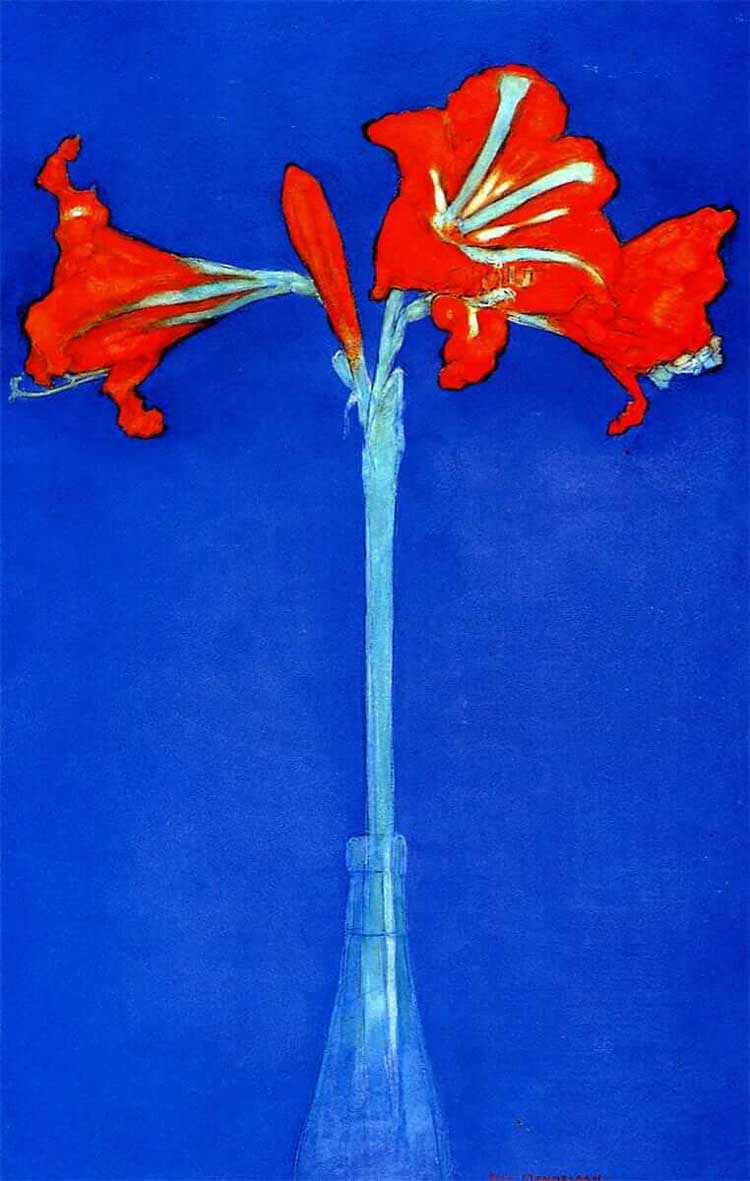
Piet Mondrian, Red Amaryllis with Blue Background, 1909–10. Watercolour on paper, 46.5 x 33 cm. Private Collection.
From the beginning, it is clear that theosophy and anthroposophy – Rudolf Steiner’s more Christian-centric offshoot – are what primarily unite Af Klint and Mondrian. And intellectual affinity is a point of departure from which their art diverges. For Mondrian, painting remains paramount, becoming increasingly non-representational, whereas for Af Klint communication seems to have always been key, whether guided by a spiritual vision or depicting the life of the soul. “The greenery of the earth is the bottom of the cube, the blue air is its roof, and the water-filled part is situated at the that section of the cube that I rest my back against,” she wrote in 1917. The abstraction pursued by Af Klint is symbolic and diagrammatic, directly pertaining to a lived and embodied experience to which she ardently applied a searching, investigative eye. To no small extent, it fascinates in the way that Leonardo da Vinci’s drawings do, and she was comparably multidisciplinary. The contrast is pronounced in a room of flower studies: while Af Klint is sharp, detailed, botanical, Mondrian extracts from his subject its painterly potential “in order that I might better express its plastic structure”.
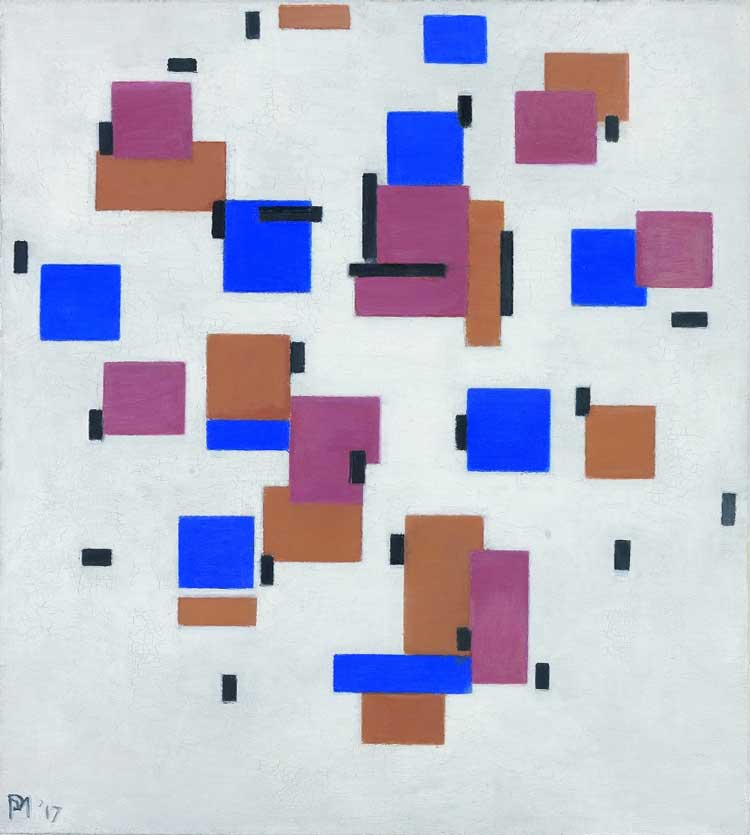
Piet Mondrian, Composition in colour B, 1917. Oil on canvas, 50.5 x 45 cm. Collection Kröller-Müller Museum, Otterlo, the Netherlands.
The exhibition revolves around a room titled “The Ether”, referring to the invisible, connective energy between things, the magic of which began to captivate scientific and occult circles across Europe in the early 19th century. Among its assortment of esoterica, the room includes two of Steiner’s cosmic blackboard drawings (1921 and 1922); De Fem’s automatisms; Af Klint’s notebooks (1919-1920) cataloguing “Flowers, Mosses, Lichen” according to their scientific and spiritual properties, and her diagrams of (ocular) irises. Her studies fit neatly into this intellectual framework, whereas Mondrian corresponds with it from the porous, and yet somewhat distinct, realm of art. In his drawings of shorelines and trees, interconnectivity galvanises the line itself, infusing his exploration of cubism after his move to Paris in 1912. It is by way of a substructural correspondence, rather than representation or illustration, that Mondrian’s lines relate to the networked world – to which he maintains an acute and emotive sensitivity, powerfully manifest in his earlier The Blue Tree (1908-09) and Avond (Evening): The Red Tree (1908-10), displayed in a separate room.
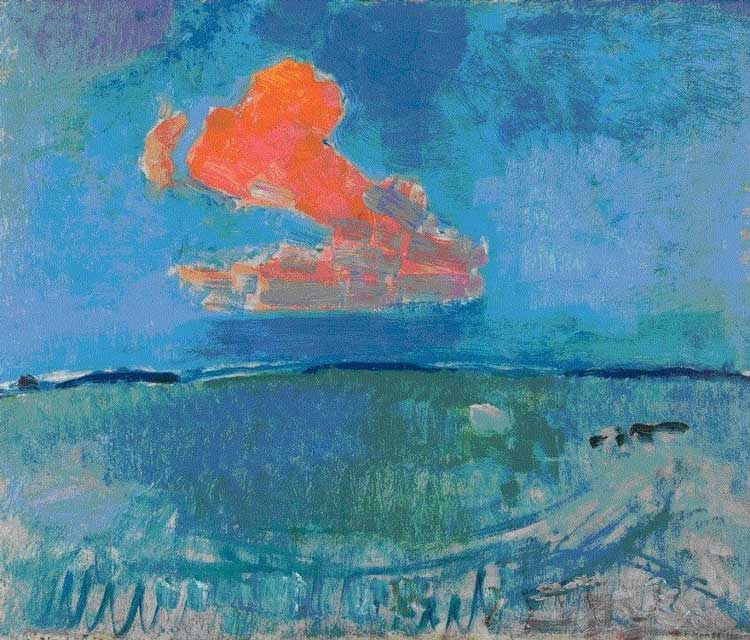
Piet Mondrian, The Red Cloud, 1907. Oil on cardboard, 64 x 75 cm. Kunstmuseum Den Haag.
Showing Af Klint alongside Mondrian does more than insert an overlooked female artist into the canon. It reminds us of the diversity of ways in which people were thinking about and through art at the turn of the 20th century. This era was not just about secularity, modern science and technology, but there was a deep spiritual element working in tandem with, and perhaps also against, these developments. One feels a resonance with the esoteric fever that animates contemporary art today, often teaming up with cutting-edge (digital) technology. As such, Mondrian’s Evolution – often deemed too spiritual, too odd, to be included in past exhibitions of his work – would not be out of place beside the techno-mystical practices of, for example, Saya Woolfalk or Tabita Rezaire. Seeing his famous grid paintings exhibited here brings out the complexity of their ethereal underpinnings – felt especially in one room, where his Lozenge Composition with Yellow Lines (1933) looms like a church window above Af Klint’s Parsifal series (1916), an absorbing sequence of circles and squares, which could almost be watercolour-dyed samples of the ether itself.
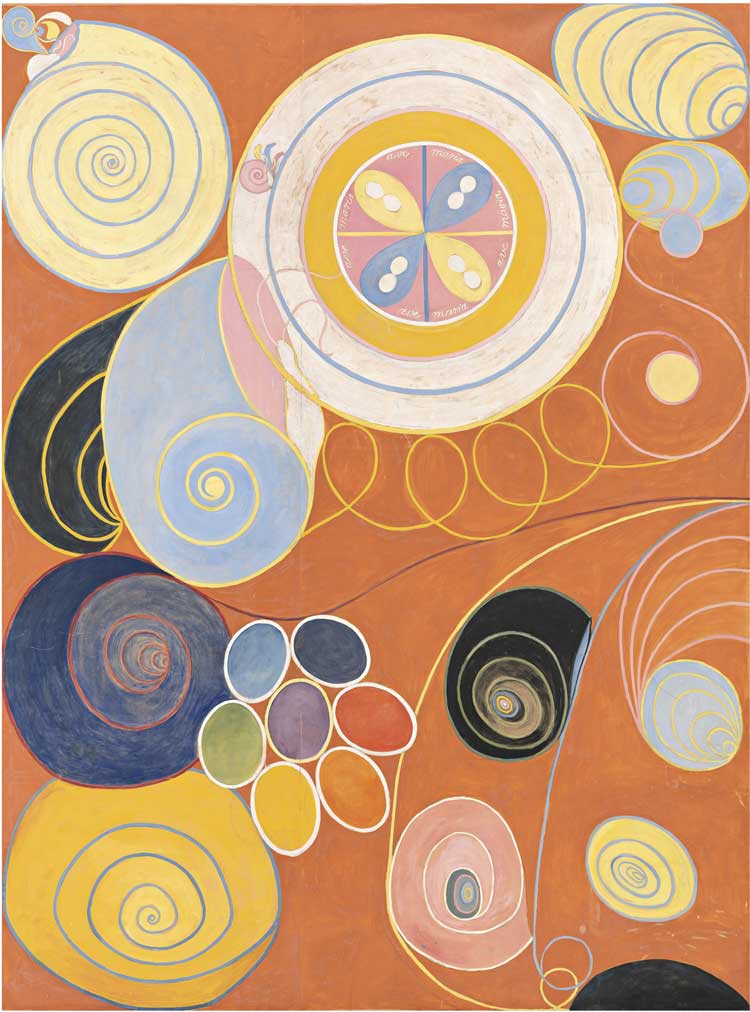
Hilma af Klint, The Ten Largest, Group IV, No. 3, Youth, 1907. Courtesy of The Hilma af Klint Foundation.
The final room is dedicated to 10 large canvases from Af Klint’s Temple series, these ones (all 1907) describing “the path of the soul from the beginning of the spectacle of life to its end”. As this journey progresses from childhood to old age around the room, the immersion defies clear linearity, and Af Klint’s pictorial language welcomingly intertwines with our own bodies. The spirals, circles, loops, petals and snails – the latter symbolising the evolution of consciousness – the balletic interactions, colour-switches and metamorphoses, seem to bubble and swirl in all directions. There is love in the kissing of shapes, in life’s reproductive motions – as a tadpole-like squiggle rubs its cheek against, or perhaps even sniffs the rear end of, a scarlet petal. Love in the reconciliation of yellow and blue, in the dovetailing lines of a yellow-and-black gourd giving way to numerated Venn-diagrammatic zones. And there is vulnerability in the tentative strokes and faded hues of the two canvases representing old age. Only in art do we get so near to biological proof of the existence of the soul.